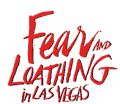[click photos Distributor |
Terry Gilliam's Fear and Loathing in Las Vegas is a deliberately incoherent evocation of the counterculture's self-destruction. Naturally, any description of the movie will fail to capture its hyperbolic mania, but it's fair to say that at its most delirious, the movie is an acid-headed gate-crashing party turned paranoid all-night bacchanal. At its most reflective, the movie is a reptilian jaunt through the gaudy fringes of diseased Americana circa 1971. Hunter S. Thompson's landmark work of gonzo journalism is an unexpectedly lucid and ferociously personal account of the '60s' slow-death by self-intoxication and absorption. Gilliam's film adaptation is anything but clear — a hazy, psychedelic mind-fuck of increasingly literal-minded insanity that sent mainstream critics to heights of invective and multiplex audiences scurrying towards exits — which makes the Criterion Collection's DVD release of this problematic and oft-dismissed work all the more necessary. Though the abundance of supplemental material (including commentary tracks by Gilliam, stars Johnny Depp and Benicio Del Toro, and Thompson himself) sheds ample light on the film's many corners, the essential nature of Gilliam's mutant creation remains unpinable. Perhaps critic J. Hoberman put it best when he wrote, in an essay included with the DVD: "This is a low-brow art film, an egghead monster movie, a gross-out trip to the lost continent of Mu, a hilarious paean to reckless indulgence, and perhaps the most widely released midnight movie ever made." Surprisingly, Fear and Loathing was a studio production, financed by Universal and released nationwide in the summer of 1998. (It had its world premiere at the Cannes Film Festival earlier that same year.) Originally adapted by writer-director Alex Cox, Fear and Loathing eventually passed to Gilliam who, along with co-screenwriter Tony Grisoni, made the decision to remain loyal to the spirit and structure of the source. Gilliam's film begins with the same line that invokes Thompson's descent into psychosis: "We were somewhere around Barstow on the edge of the desert when the drugs began to take hold." This opening salvo on the nervous system of both the audience and the two lead characters unleashes a non-stop torrent of hallucinations, dreams, and visions — all of which hover creepily on the tangible. Depp plays Thompson alter ego Raoul Duke, a writer on assignment for Esquire to cover a motorcycle race somewhere in the Nevada desert. Riding shot-gun in their white convertible is his "attorney" — a permanently disheveled, Hawaiian-shirt clad, profanity-spewing bullfrog of a man named Dr. Gonzo (Del Toro). And in the trunk is every illegal drug imaginable: mescaline, dope, heroin, acid, cocaine, grass … just to name a few. When not ingesting these pills and powders, this inseparable duo is imbibing all sorts of alcoholic potables (and sometimes non-potables). Thompson's prose (first published in Rolling Stone magazine) came complete with phantasmagoric illustrations by British artist Ralph Steadman. Faithfully re-creating the look and feel of these sketches, Gilliam envisions the eponymous desert city as a nightmarish, two-dimensional smorgasbord of exploding bodies and infinitely stretchable flesh. In one scene, a lounge full of high-class lushes mutates into an orgy of prehistoric lizards, and then into an all-out blood bath. Another scene finds Depp's Duke sporting a similarly Lacertilian tail, albeit a strap-on. But whereas Steadman's art is black-and-white, Fear and Loathing explodes with garish neons and fluorescents — flower-power hues turned sickly with age. Even in the depths of their hotel room cum narcotic foxhole, Duke and Gonzo are bombarded with blue-purple-orange color schemes and filtered lights. A metaphorical war zone, Las Vegas stands in for America at large — a burned out fabric irreparably rended by Vietnam, the Civil Rights movement, and the Nixon administration. The appalling gaudiness acts as the visual counterpart to the often indecipherable mutterings of the two leads, with Depp affecting an uncanny Thompson-ish drawl. It's all static interference that obscures rational thought. The Criterion Collection's DVD release offers an impressive compilation of late '60s and early '70s artifacts, but it amounts to little more than a hagiographic tribute to its gonzo pioneer. In addition to the audio commentary tracks, there's a feature length BBC documentary on Thompson and Steadman, several deleted scenes, original artwork by Steadman, and a short video doc featuring Depp reading a collection of Thompson's correspondences. Completists will have field day, but most viewers will find the set slavish and adulatory to a fault. Fear and Loathing remains a wildly uneven, daringly discombobulating, yet unforgettable experiment — a '90s time capsule of the '60s that in the end is more satisfying to write about than it is to experience.
Fear and Loathing in Las Vegas is now available on DVD from The Criterion Collection as a two-disc set. The digital transfer was approved by director Terry Gilliam and enhanced for widescreen televisions. Special features: three audio commentary tracks (by Terry Gilliam, by Johnny Depp, Benicio Del Toro, and producer Laila Nabulsi, and by Hunter S. Thompson); an audio interview with Hunter S. Thompson; deleted scenes, with commentary by Terry Gilliam; storyboards and production designs; original artwork by illustrator Ralph Steadman; Fear and Loathing on the Road to Hollywood, a BBC feature documentary with Hunter S. Thompson and Ralph Steadman; a selection of Hunter S. Thompson's correspondence read on-camera by Johnny Depp; rare material on Oscar Zeta Acosta, the attorney on whom the character Dr. Gonzo is based; and a stills gallery. Suggested retail price: $39.95 each. For more information, check out the Criterion Collection Web site.
|








